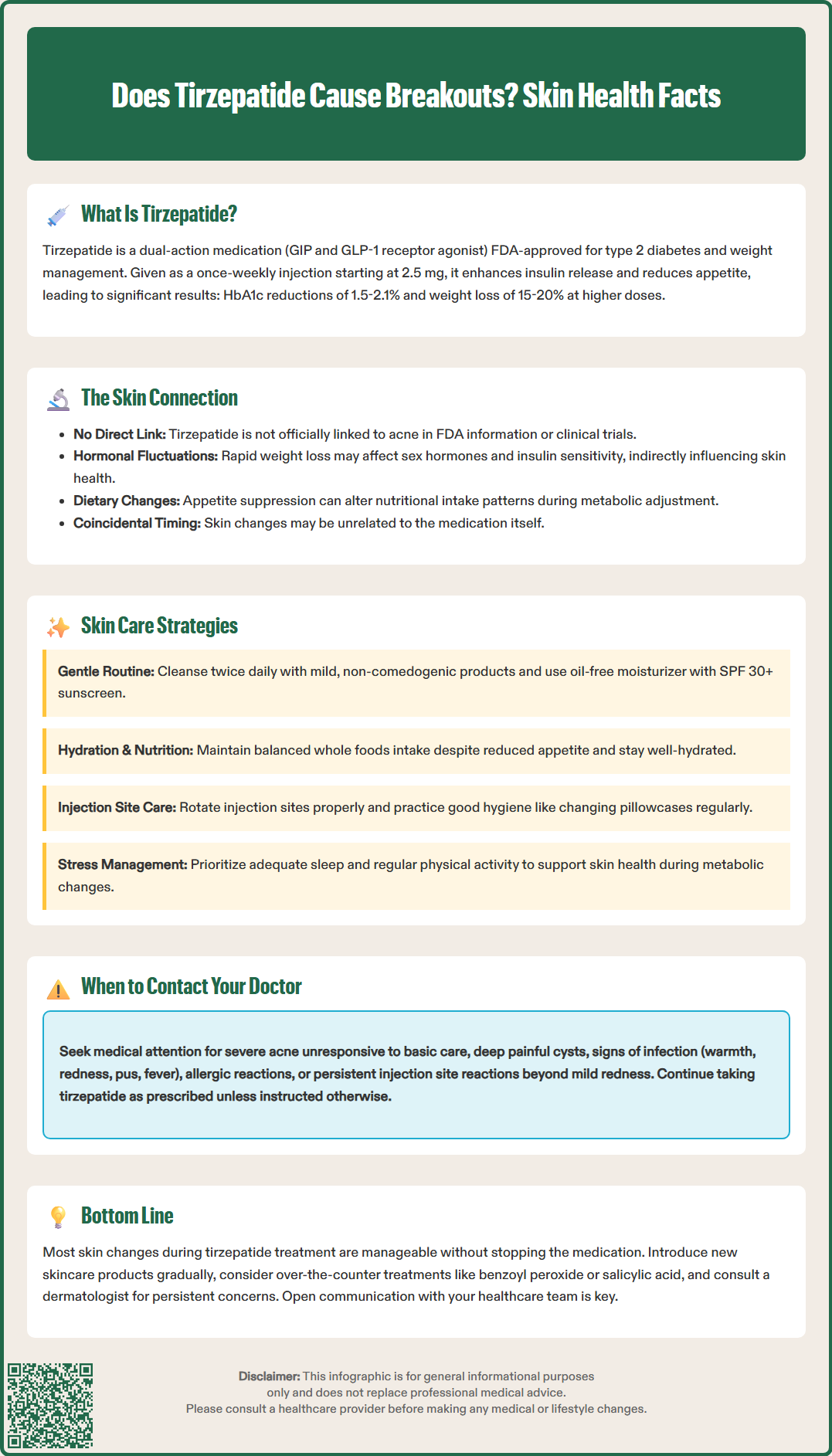LOSE WEIGHT WITH MEDICAL SUPPORT — BUILT FOR MEN
- Your personalised programme is built around medical care, not willpower.
- No generic diets. No guesswork.
- Just science-backed results and expert support.
Find out if you’re eligible

Many patients starting tirzepatide wonder whether this medication might affect their skin, particularly regarding breakouts or acne. Tirzepatide (Mounjaro for type 2 diabetes, Zepbound for weight management) is a dual GIP and GLP-1 receptor agonist that has transformed metabolic treatment. While breakouts are not listed as a recognized adverse effect in FDA prescribing information, some individuals report skin changes during therapy. Understanding the relationship between tirzepatide and skin health—including potential indirect mechanisms, management strategies, and when to seek medical evaluation—helps patients navigate treatment confidently while maintaining optimal dermatologic care.
Quick Answer: Tirzepatide does not have an established direct causal link to acne breakouts based on current FDA-approved prescribing information and clinical trial data.
Tirzepatide is a dual glucose-dependent insulinotropic polypeptide (GIP) and glucagon-like peptide-1 (GLP-1) receptor agonist approved by the FDA for the treatment of type 2 diabetes mellitus (marketed as Mounjaro) and chronic weight management (marketed as Zepbound). This medication addresses both glycemic control and weight management through its dual-receptor mechanism.
The medication works through multiple complementary mechanisms. By activating GIP receptors, tirzepatide enhances insulin secretion in a glucose-dependent manner, meaning it stimulates insulin release only when blood glucose levels are elevated. Simultaneously, GLP-1 receptor activation suppresses glucagon secretion, slows gastric emptying, and promotes satiety through central nervous system pathways. These combined actions result in improved postprandial glucose control, reduced appetite, and weight loss.
Tirzepatide is administered as a once-weekly subcutaneous injection, with dosing typically initiated at 2.5 mg for 4 weeks, then increased in 2.5 mg increments every 4 weeks as tolerated, up to a maximum of 15 mg weekly. In clinical trials, patients with type 2 diabetes experienced HbA1c reductions that varied by dose (typically 1.5-2.1%), while weight loss in obesity treatment ranged from 15-20% of baseline body weight at the highest doses. Common adverse effects include gastrointestinal symptoms such as nausea, vomiting, diarrhea, and constipation, which are generally mild to moderate and diminish over time. While tirzepatide has a low risk of hypoglycemia when used alone, this risk increases when combined with insulin or sulfonylureas. Understanding the medication's mechanism is essential when evaluating potential dermatologic effects, as metabolic and hormonal changes during treatment may influence skin physiology.

While breakouts and acne are not listed as adverse effects in the FDA prescribing information for tirzepatide, some patients report skin changes during treatment. It is important to note that there is no established direct causal link between tirzepatide and acne breakouts based on current clinical trial data. However, several indirect mechanisms might hypothetically explain why some individuals experience dermatologic changes while taking this medication.
Rapid weight loss, a common effect of tirzepatide therapy, can trigger hormonal fluctuations that may affect skin health. As adipose tissue decreases, alterations in sex hormone metabolism, insulin sensitivity, and inflammatory markers occur. These metabolic shifts could potentially influence sebaceous gland activity and skin cell turnover in some individuals. Improved insulin sensitivity from tirzepatide treatment may actually reduce androgen levels in some patients with insulin resistance, which could theoretically improve acne for some while having variable effects in others.
Dietary modifications often accompany tirzepatide treatment due to appetite suppression and intentional lifestyle changes. Patients may alter their nutritional intake patterns, sometimes increasing consumption of certain food groups that could influence skin health. Furthermore, the adjustment period to significant body composition changes and metabolic adaptation may temporarily affect skin condition.
It is also essential to consider that correlation does not imply causation. Many patients initiating tirzepatide are simultaneously making multiple lifestyle modifications, experiencing hormonal changes related to weight loss itself, or may have pre-existing dermatologic conditions that become more noticeable during this period of heightened body awareness. Distinguishing between medication effects and coincidental skin changes requires careful clinical evaluation.
Maintaining optimal skin health during tirzepatide treatment involves a comprehensive approach that addresses both general dermatologic care and factors specific to metabolic medication therapy. Patients should establish a consistent, gentle skincare routine that supports skin barrier function without exacerbating potential breakouts.
Basic skincare recommendations include:
Cleansing twice daily with a mild, non-comedogenic cleanser appropriate for your skin type
Using oil-free, non-comedogenic moisturizers to maintain skin hydration
Applying broad-spectrum sunscreen daily (SPF 30 or higher)
Avoiding harsh scrubs or over-cleansing, which can disrupt the skin barrier and worsen breakouts
Changing pillowcases regularly and avoiding touching the face frequently
Rotating injection sites properly to minimize local skin reactions
Nutritional considerations are particularly relevant during tirzepatide therapy. Despite reduced appetite, maintaining adequate hydration and balanced nutrition supports skin health. Focus on obtaining nutrients through whole foods rather than supplements. If considering supplements, consult your healthcare provider first, particularly regarding vitamin A, as excessive amounts can cause skin problems and other adverse effects. Some patients benefit from keeping a food and symptom diary to identify potential dietary triggers for skin changes.
Stress management and adequate sleep are often overlooked factors in skin health. The metabolic changes and lifestyle adjustments accompanying tirzepatide treatment can be physically and emotionally demanding. Implementing stress-reduction techniques such as regular physical activity, mindfulness practices, or adequate rest may help minimize stress-related skin flares.
Patients should avoid initiating multiple new skincare products simultaneously, as this makes it difficult to identify beneficial versus problematic interventions. If over-the-counter acne treatments are considered, products containing benzoyl peroxide, salicylic acid, or adapalene may be appropriate, but should be introduced gradually and with attention to skin tolerance. Note that topical retinoids like adapalene should be avoided during pregnancy. Consultation with a dermatologist can provide personalized guidance, particularly if breakouts are persistent or severe.
While mild skin changes during tirzepatide treatment may not require immediate medical attention, certain presentations warrant prompt evaluation by a healthcare provider. Understanding when to seek professional guidance ensures appropriate management and helps distinguish between benign skin changes and potentially serious adverse reactions.
Contact your healthcare provider if you experience:
Severe or worsening acne that does not respond to basic skincare measures
Painful, deep nodules or cysts that may indicate nodulocystic acne requiring prescription therapy
Signs of skin infection, including increased warmth, spreading redness, purulent drainage, or fever
Allergic reactions such as hives, widespread rash, or facial swelling (call 911 for difficulty breathing or severe allergic reactions)
Injection site reactions beyond mild, transient redness—including persistent pain, swelling, ulceration, or signs of infection
Any rash accompanied by systemic symptoms such as fever, joint pain, or malaise
Skin changes that significantly impact quality of life or psychological well-being
Your healthcare provider can assess whether observed skin changes represent a medication adverse effect, a manifestation of metabolic changes during treatment, or an unrelated dermatologic condition requiring specific intervention. They may recommend dermatology referral for specialized evaluation and management, particularly if prescription acne therapies such as topical retinoids, oral antibiotics, or hormonal treatments are being considered.
It is important to continue tirzepatide as prescribed unless specifically instructed otherwise by your provider. Most skin changes, if related to the medication, are manageable without discontinuation. However, your provider can help weigh the benefits of continued therapy against any dermatologic concerns and adjust the treatment plan accordingly. Never discontinue tirzepatide abruptly without medical guidance, as this may affect glycemic control and metabolic management. Remember to properly rotate injection sites according to the medication instructions to minimize local skin reactions. Open communication with your healthcare team ensures comprehensive care that addresses both metabolic health and dermatologic well-being throughout your treatment journey.
No, acne and breakouts are not listed as adverse effects in the FDA prescribing information for tirzepatide (Mounjaro or Zepbound). Clinical trial data has not established a direct causal link between tirzepatide and acne.
Rapid weight loss from tirzepatide may trigger hormonal fluctuations and metabolic shifts that could indirectly affect skin health in some individuals. Dietary changes, improved insulin sensitivity, and the body's adjustment to significant metabolic changes may also influence skin condition.
Contact your healthcare provider for severe or worsening acne, painful nodules or cysts, signs of skin infection, allergic reactions, persistent injection site reactions, or any skin changes that significantly impact your quality of life.
All medical content on this blog is created using reputable, evidence-based sources and is regularly reviewed for accuracy and relevance. While we strive to keep our content current with the latest research and clinical guidelines, it is intended for general informational purposes only.
This content is not a substitute for professional medical advice, diagnosis, or treatment. Always consult a licensed healthcare provider with any medical questions or concerns. Use of this information is at your own risk, and we are not liable for any outcomes resulting from its use.